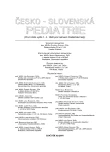Changes in Iodine Supplementation after Eradication of Iodine Deficit and Their Possible Causes. A Randomized Study of Children Population in Two Regions of the Czech Republic with a Time Lapse of 5 Years. First Publication of the Results
Změny v zásobení jódem po eradikaci jódového deficitu a jejich možné příčiny Randomizovaná studie dětské populace dvou regionů České republiky s odstupem 5 let První publikace výsledků
Účel studie:
Ve druhé polovině 90. let se v České republice podařilo nedostatek jódu podstatně snížit. Vývoj změn v zásobení populace jódem je však nutné dále monitorovat, případně hledat jejich příčiny. Cílem studie bylo zachytit změny v jodurii dětí a hledat příčiny těchto změn ve stravovacích zvyklostech.
Metody:
V letech 1999, 2000, 2004 a 2005 byl vyšetřen reprezentativní soubor 1209 dětí ve věku 6, 10 a 13–17 let, s trvalým bydlištěm v regionu Jablonec nad Nisou nebo Příbram. Jodurie jako obraz příjmu jódu byla stanovena alkalickou spalovací metodou na základě Sandellovy-Koldhoffovy reakce. Informace o nutričních zdrojích jódu byly získány dotazníkem a kontrolovaným řízeným rozhovorem.
Výsledky:
V průběhu 5 let došlo v obou sledovaných regionech k signifikantnímu zvýšení průměrných hladin jodurie ze 140 ± 3,69 na 221 ± 8,66 μg/l. V obou regionech se podstatně zvýšila frekvence osob s nadnormální jodurií (nad 300 μg/l): z 0 % na 24 % na Jablonecku a z 0 % na 32 % u dětí z Příbramska. Na Příbramsku však došlo k signifikantnímu snížení frekvence dětí v kategorii optimální jodurie (100 až 300 μg/l) Prevalence nedostatečného příjmu jódu (do 50 μg/l) se signifikantně nezměnila. Z testovaných nutričních změn, které by mohly hladinu jodurie ovlivnit, bylo zachyceno signifikantní zvýšení spotřeby minerálních vod s jódem a zvýšení konzumace mořských ryb den před vyšetřením (na Příbramsku). V průběhu pěti let bylo také zjištěno signifikantní snížení počtu dětí, které jsou vystaveny působení thiocyanátu z cigaretového kouře (pobyt v zakouřeném prostoru déle než 1 hodinu denně). Vícefaktorová analýza rozptylu vlivu 4 hlavních nutričních zdrojů jódu (konzumace mléka, mořských ryb, vajec a soli) ukázala, že hladinu jodurie dětí nejpodstatněji ovlivňuje pravidelnost pití mléka.
Klíčová slova:
jodurie, výživa, děti, regiony České republiky
Authors:
J. Čeřovská; R. Bílek; M. Dvořáková; H. Zamrazilová; P. Hoskovcová; M. Vosátková; V. Zamrazil
Authors‘ workplace:
Endokrinologický ústav, Praha
ředitel doc. MUDr. V. Hainer, CSc.
Published in:
Čes-slov Pediat 2007; 62 (2): 65-72.
Category:
Original Papers
Overview
Introduction:
Iodine, as well as a series of other elements important for heath, occupies a certain optimal dose range of daily intake. It is therefore important for humans to avoid shortages as well as excessive supply. In the second half of 90ties the previous shortage of iodine has been significantly adjusted. The evolution of changes in the population supply with iodine should be further monitored or their causes explored. Objective: to detect changes in iodine in urine (“ioduria”) of children and to look for causes of these changes in the nutritional habits
Methods:
In 1999, 2000, 2004 and 2005 the authors examined a representative cohort of 1209 children at the age of 6, 10 and 13–17 years, living permanently in the region of Jablonec nad Nisou or Příbram. Ioduria as a reflection of iodine intake was determined by the combustion method on the basis of the Sandell-Koldhoff reaction. Information on possible nutritional sources or iodine (sea fish, milk, salting, eggs, and mineral water) was obtained by questionnaire and guided interview.
Results:
In the course of 5 years there was significant increase in the mean iodine levels in urine from 140 ± 3.69 to 221 μg/l ± 8.66. In both regions there was a significant increase in the frequency of persons with excessive ioduria (above 300 μg/l): it was from 0 to 24% in the Jablonec region and from 0 to 32% in children from the Příbram area. In the latter region there was a significant decrease in the frequency of children in the category of optimal iodinuria (100 to 300 μg/l) from 86 % in the year 2000 to 53.5 % in 2005.
The prevalence of insufficient iodine intake (up to 50 μg/l) was in the range of 0.7 to 2%. The changes in this category were not statistically significant. In the tested nutritional changes, which could influence the level of iodine in urine, the authors noticed a significant increase in the consumption of mineral water containing iodine: their consumption increased in the course of 5 years from 12% to 15% in the Jablonec region and from 33% to 49% in the Příbram region.
A significant increase of sea fish consumption the day preceding the examination was encountered only in children in the Příbram region. In the course of five years there was also a significant decrease in the number of children exposed to thiocyanates from cigarette smoke (stay in the smoke-polluted environment more than an hour a day). Multifactorial analysis of variance of four main nutritional iodine sources (consumption of milk, sea fish, eggs and salt) revealed that regular drinking of milk most significantly influenced ioduria in children. The children having not drunk milk displayed ioduria of 150 μg/l, whereas those who drank milk daily had ioduria of 187 μg/l. The difference was statistically significant at 95% level of significance.
Key words:
urinary iodine, nutrition, children, regions of the Czech Republic
Labels
Neonatology Paediatrics General practitioner for children and adolescentsArticle was published in
Czech-Slovak Pediatrics

2007 Issue 2
- What Effect Can Be Expected from Limosilactobacillus reuteri in Mucositis and Peri-Implantitis?
- The Importance of Limosilactobacillus reuteri in Administration to Diabetics with Gingivitis
Most read in this issue
- Multiple Intracranial Complications of Pansinusitis in Children
- Continual Monitoring of Electric Brain Activity in Newborns (aEEG – Amplitude Integrated EEG)
- Bone Marrow Transplantation in Children – Parents’ Point of View
- Teratogenic Phenylketonuria-related Embryopathy
